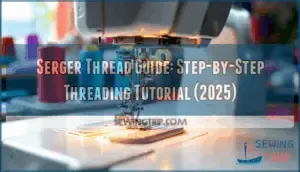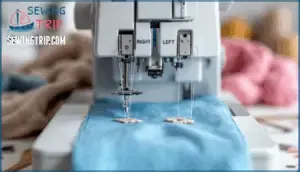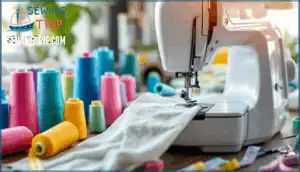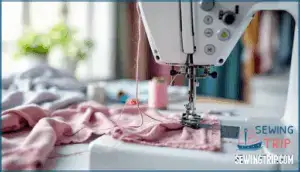This site is supported by our readers. We may earn a commission, at no cost to you, if you purchase through links.
 Threading a serger can feel like solving a puzzle with a dozen moving parts, especially when each thread has its own secret path. One wrong move, and even the most reliable machine will tangle, skip, or grind to a halt.
Threading a serger can feel like solving a puzzle with a dozen moving parts, especially when each thread has its own secret path. One wrong move, and even the most reliable machine will tangle, skip, or grind to a halt.
But once you understand the serger thread guide system, the whole process falls into place—smooth, fast, and almost satisfying.
Whether you’re aiming for crisp seams or finishing edges that look store-bought, mastering the right threading order and tension will transform your sewing game from frustration to flow.
Table Of Contents
Key Takeaways
- Threading your serger in the correct order—upper looper, lower looper, then needles—is crucial for smooth, balanced stitches.
- Using color-coded guides and lifting the presser foot makes threading easier and helps keep tension discs properly engaged.
- Choosing high-quality threads and matching them to your fabric type prevents breakage and improves stitch results.
- Regular maintenance, like cleaning lint and replacing needles, keeps your serger running smoothly and avoids common threading problems.
Serger Machine Parts and Thread Paths
Before you thread your first spool, you need to know what you’re working with. A serger isn’t complicated, but each part plays a specific role in creating those clean, professional stitches.
Let’s break down the essential components that make threading easier once you understand how they work together.
Key Components of a Serger
A serger machine is built around five essential parts that work like a synchronized team to create professional-quality stitches. The upper looper and lower looper form the overlock stitch, while the needle types shape how your seam comes together. Tension discs control thread flow through the machine, and the presser foot keeps your fabric steady during sewing.
The differential feed prevents puckering on stretchy materials, making serger maintenance and proper threading order essential for consistent results.
Understanding Thread Guides and Tension Disks
Thread guides and tension disks act as the traffic controllers of your serger, directing each spool along its designated path while keeping the thread flowing at just the right speed. These components prevent threading errors by maintaining consistent thread tension throughout each stitch cycle.
When tension discs are properly engaged—which happens when you lift the presser foot—your thread paths stay organized and your stitch quality remains balanced. Understanding how these parts work together makes the threading order easier to follow and helps you troubleshoot fabric settings when needed.
Color-Coded Threading Systems
Most modern sergers feature color-coded systems that match each thread path to a specific spool position, turning what could be a confusing maze into a straightforward map you can follow with confidence. These color coding systems use matching markers on thread guides and tension discs to show you exactly where each cone belongs.
Look for colored dots, numbers, or lines that correspond to the threading order—upper looper, lower looper, then needles—making thread management virtually foolproof even on your first attempt.
Threading Order and Essential Techniques
Threading your serger in the right order isn’t just helpful—it’s essential. Get the sequence wrong, and you’ll end up with loose stitches, thread snaps, or worse.
Here’s what you need to know to thread with confidence every time.
Correct Threading Sequence Explained
If you’ve ever looked at the back of a serger and felt like you’re staring at a tangled maze of thread paths, you’re not alone—but here’s the secret: threading order is everything.
Threading a serger may look confusing, but mastering the correct order is the key to smooth, professional stitches
Always thread the upper looper first, then the lower looper, followed by needles. This method prevents snags, balances thread tension, and makes stitch formation and machine calibration easier.
Using Tweezers and Threaders Effectively
When you’re working your way through the tight spaces of a serger, a good pair of tweezers or a handy threader can feel like an extra set of fingers. Choose ergonomic tweezers types for steady control, especially around delicate fabrics.
Needle threading demands patience and precision. Metal threader materials generally last longer, making precision threading a smoother, more reliable part of your technique.
Lifting The Presser Foot for Threading
Start by raising the presser foot—this simple move gives your threads the space and freedom they need to glide smoothly into place. Doing so triggers tension disc release, letting you thread each guide without obstruction.
This step matters for:
- Threading Ease
- Preventing Damage
- Consistent Threading
- Maintaining correct tension for every upper looper and needle in your threading order.
Step-by-Step Serger Threading Tutorial
Threading your serger doesn’t have to be a guessing game. With a clear process and a bit of patience, you can set up your machine for smooth sewing every time.
Here’s how to tackle each step.
Preparing Your Serger and Thread Cones
Getting your serger ready is like setting the stage for a smooth performance—every spool and guide needs its place before the show begins. Start by checking thread selection, lining up your thread cones, and making sure threading tools are on hand. Clean tension discs, prep your fabric, and double-check cone management. Here’s a quick prep table:
| Thread Selection | Cone Management | Serger Maintenance |
|---|---|---|
| Match to fabric | Balance cones | Clean guides |
| Polyester/Nylon | Equal lengths | Check tension |
| Specialty types | Secure bases | Oil moving parts |
| Color-coded | Organize order | Inspect needles |
Threading The Upper Looper
Think of threading the upper looper as laying the foundation for every stitch your serger will make—get this step right, and the rest falls into place.
Use these steps for a smooth start:
- Guide thread through Looper Guides and Upper Tension.
- Check Thread Length for even feed.
- Use Threading Tools for tricky Looper Thread Path spots.
Threading The Lower Looper
Ready to tackle the trickiest part of serger threading? The lower looper is where patience pays off and precision matters most. Guide the thread along the Looper Thread Path, using Lower Looper Tips for tight angles. Follow the threading sequence closely—tweezers help.
Watch your serger thread tension and check for smooth movement. Looper adjustment techniques guarantee balanced stitches.
Threading Right and Left Needles
If threading the needles feels like threading the eye of a storm, don’t worry—you’re almost at the finish line. Make sure your right and left needles sit straight for proper Needle Alignment. Guide each thread through its path, watching Thread Tensioning and Stitch Formation. Remember, Serger Calibration matters. If a needle’s bent, Needle Replacement is your friend.
- Double-check needle placements for perfect alignment
- Use tweezers for precise needle threading
- Follow the thread guide for each needle’s path
- Adjust tension dials for balanced stitches
- Replace dull needles to avoid skipped stitches
Creating a Balanced Chain Stitch
Once your needles are threaded and lined up, it’s time to see how everything comes together in a smooth, balanced chain stitch. Test your Stitch Formation over a fabric scrap—look for even loops and tension balance as you sew. Here’s a quick reference for troubleshooting and tweaking your chain stitch:
| Checkpoint | What to Watch For |
|---|---|
| Thread Tension | Balanced, no puckering |
| Thread Lengths | Equal for smooth sewing |
| Stitch Formation | Consistent, no gaps |
| Fabric Stretch | Stays flat, not stretched |
| Overlock Stitch | Uniform, neat edge |
Selecting and Managing Serger Threads
Finding the right thread for your serger makes all the difference in your final results. It’s not just about color—thread type, application, and size each have a role to play. Here’s what you’ll want to keep in mind as you choose your threads.
Choosing The Right Thread Type
Thread selection is all about matching your project’s needs to the right thread materials and weight options. Polyester thread offers durability and flexibility, while nylon excels for stretch. Cotton works for natural fiber projects, but watch for breakage.
Consider fiber blends, color selection, and texture choices. High-quality thread cones guarantee compatibility and smooth stitching, making your serger work smarter.
Selecting threads requires considering industrial machine operation for ideal results.
Standard Vs. Specialty Thread Applications
When you’re weighing thread type for project suitability, consider the fabric weight and desired stitch appearance. Standard polyester manages most seams and offers strong seam durability. Specialty threads—like metallic or woolly nylon—shine for decorative finishes or stretchy knits.
Matching thread quality and tension to your material guarantees the right look, feel, and performance for every sewing challenge. For best results, choosing the right serger thread type is essential to achieve professional-looking seams.
Thread Cone Size and Performance
After you’ve chosen the right thread for your project, it’s worth knowing how the size of your serger cones can impact both your workflow and stitch quality. Larger cones mean fewer interruptions, but there’s more to it:
- Longer thread lengths reduce rethreading.
- Consistent thread tension improves results.
- Cone sizes fit different yarn weights.
- Thread quality varies by fiber types.
Troubleshooting Serger Threading Issues
Even the most careful threading can run into snags now and then. If your serger isn’t stitching smoothly, a few common problems might be to blame.
Let’s look at some practical ways to get things back on track.
Fixing Thread Jams and Breakage
Ever notice how thread breakage can halt your momentum mid-seam? Most jams trace back to tension settings, poor thread quality, or skipped guides.
For jam prevention, clean lint from tension disks, replace aged cotton, and check for burrs. Regular maintenance tips—like oiling moving parts—keep your serger humming.
Troubleshooting starts with retracing the threading path, step by step.
Adjusting Thread Tension for Balanced Stitches
Getting the hang of thread tension is the secret sauce to making your serger stitches look sharp and even, no matter what fabric lands under your presser foot. Adjusting tension settings isn’t guesswork—think of it as fine-tuning a musical instrument.
Try these steps for reliable tension balance:
- Test on scrap fabric
- Adjust each dial separately
- Watch stitch quality closely
- Balance thread tension
- Calibrate for fabric tension
Maintenance Tips for Smooth Threading
Regular care goes a long way in keeping your serger running smoothly and making the threading process much less of a headache. Wipe away lint, oil moving parts, and check tension settings. Store your machine covered and dry.
Here’s a quick reference:
| Thread Care | Machine Cleaning |
|---|---|
| Use quality thread | Clean tension disks |
| Equal thread lengths | Oil moving parts |
| Cover for storage | Remove lint often |
Frequently Asked Questions (FAQs)
How to thread a serger machine?
To thread a serger machine, follow the thread guide and use threading tools for each looper and needle. Lift the presser foot, check tension discs, and select high thread quality for reliable sewing techniques and smooth serger maintenance.
How do you Serge a machine with a serger?
To Serge a machine with a serger, follow the serger threading steps precisely. Use the thread guide and tension disc, choose suitable threads for your fabric selection, and calibrate the machine for ideal sewing techniques and consistent serger maintenance.
How do you thread an overlocker on a serger?
Picture guiding colored threads through a maze—each path matters. Start with the upper looper, then the lower looper, followed by both needles.
Use threading tools, lift the presser foot, and check thread tension for perfect overlock stitches.
How do I know if my Serger thread is correct?
You’ll know your serger thread is correct when Stitch Quality is even, Thread Tension is balanced, and you don’t see Thread Breakage.
Double-check Serger Settings and verify your thread selection matches your fabric compatibility for best results.
How do you use a serger needle threader?
Imagine threading a serger needle as threading a needle in a haystack—precision matters.
Use a universal needle threader: align the wire loop with the needle eye, guide the thread through, and avoid threading errors for top stitch quality.
How many threads does a serger use?
Most serger machines use four threads for ideal stitch formation. This Thread Count includes two needle threads and two looper threads. Depending on your Machine Capacity, some models manage three or even five threads for specialty overlock stitching.
Can I use regular sewing thread in a serger?
Have you wondered if your serger machine can manage regular sewing thread? While thread compatibility matters, using standard thread cones brings risks—like breakage and uneven tension settings.
Thread substitution can work, but thread quality and serger thread limits still apply.
How often should I replace serger needles?
You should swap out serger machine needles after every major project or when you notice skipped stitches, thread breakage, or dullness. Needle replacement and maintenance keep Needle Sharpness high and prevent Serger Needle Wear from affecting results.
What fabrics require special serger thread?
Think of swimwear, athletic gear, and lingerie—these stretch and delicate fabrics call for specialty threads like nylon or woolly nylon. Heavy fabrics benefit from stronger polyester.
Thread selection and tension control are key for balanced seams across fabric types.
Is it safe to oil my serger at home?
You can oil your serger at home with the right oil type and careful application methods. Always follow safety precautions and check your manual for oiling frequency.
Consider professional servicing for deeper serger maintenance of machine parts.
Conclusion
Think of threading a serger like tuning a musical instrument—each thread must follow its path for the machine to play in harmony. With this serger thread guide tutorial, you’ve learned to read the notes and set the rhythm.
Now, every stitch can sing with precision and confidence. When challenges pop up, remember: the right threading order is your sheet music.
Stay patient, trust your hands, and let your serger transform raw edges into polished, professional finishes.
- https://www.thecreativecurator.com/choosing-best-serger-thread-serger-machine/
- https://ir.library.oregonstate.edu/downloads/z029p7629
- https://www.coats.com/en/info-hub/Thread-Consumption-Guide/
- https://www.amefird.com/wp-content/uploads/2012/09/Estimating-Thread-Consumption-.pdf
- https://sewingmastery.com/5-serger-thread-tips-when-selecting-thread-colors/














